- History of Oriental Frills
- Shortface Standards
- Show Reports
- British Nun Club
- Breeding Nuns
- British Nun Standard
- Nun Club Results
- Nun Club History
- BPSS Exhibition News
- BPSS History
- BPSS Trophies
- BPSS Regs
- BPSS Hall of Fame
- BPSS Classification
- BPSS Entry Form
- Show Hall
- Gallery
- Fancy Pigeon Gallery
- BPSS Best In Show Winners
- Fanciers
- Housing
- Hints & Tips
- Donovon White, USA
- Ludlow
- National Peristeronic Soc
- Sale Birds
- Pointing The Way
- Show Dates
- BPSS Section Winners
- Directions
- LINKS
Donovon White, USA
There is an old saying among Racing Pigeon Breeders that, “the long hard races are won or
lost in the nest.”I believe this philosophy holds true for Oriental Frills as well all the short-beaked
varieties: breeding for show or for stock birds starts in the nest. Healthy young birds start with
good loft management. Although there may not be a lot of literature available specifically for
rearing Oriental Frills; there is a wealth of material available on the care and feeding of pigeons
and these basics are the essential requirement for successfully breeding Oriental Frills.
Oriental Frills are not a breed that can be successfully bred in both quantity and quality. The
most successful breeders I have known have put quality first, not quantity. So set goals for what
you want to achieve, and then work with the best stock you can obtain. The rewards of breeding
top quality Oriental Frills are well worth the time and effort you put into your program.
The pigeon fancy is not unlike running a business. The same skills required to successfully
manage a business are needed to manage a loft; such as setting goals, designing and building a
loft, purchasing supplies and stock (pigeons), record keeping, scheduling a feeding and breeding
program, managing your time, planning and shipping to shows,and selling stock,etc. How
successful you are with these skills will pay dividends in the breeding and show pen.
Further, it is a big plus if you enjoy your work. Don’t take on more breeds or projects than you
have time to give them. Frills and other short-beaked varieties require additional time and
attention in the everyday routine of pigeon raising so keep it enjoyable, rather than a burden.

The selection and care of foster parents, are of utmost
importance since theyare requiredto raise the
young Oriental Frills. The feeders loft must be
large enough for the number of pairs you’ll
need determined by how many pairs of Frills
you breed. I recommend a minimum of one
and one half pairs of feeders to each pair of
Frills, more if practical. However, loft space
and feed budget should be considered.
Remember that it cost no more to feed and
care for top quality birds as it does for culls.
The breeds used for feeders vary from one
loft to the next. The primary consideration in
selecting a particular breed should be their
parenting ability. Rearing young short-beaked varietiesis no easy task for the foster parents. If the
feeders are not top-notch parents, possessing a strong desire to raise the youngand have the
proper gape of mouth to handle wide-beaked youngsters, they will be easily discouraged and give
up. The higher the quality of your young Oriental Frillsthe more difficult they will be to rear.
Only top-notch feeders will be equal to the task. You’ll find among any breed of feeders
individual birds or pairs who take care of the young better. Building a good loft of feeders is an
ongoing task. It will require close observation,accurate records of their successes or failures, and
a lot of patience.

Good loft design is essential for the successful rearing of young Oriental Frills. Good ventilation, adequate space to exercise, dry floor litter, draft free, not overcrowded, etc. are important considerations. However, I
believe the most important thing is to observe your bird’s behavior and learn from it. They
will tell you if they are content and enjoy their loft or just surviving in a stressful environment. A well-designed and well-maintained loft is also less stressful on the health of the loft manager. A few things should be considered with regards to the loft and your pigeons. They are gregarious by nature; they like to be around other pigeons. A pigeon’s main purpose in life is to reproduce itself; they need their own space to court their mate, exercise, nest and roost. If adequate space is not provided, they will feel threatened and fight, causing an unsettled loft, broken eggs and injury or death to youngsters. I don’t know of any exact science for determining the size or arrangement of the loft, but a good rule to follow for the breeding loft is to provide 7 to 8
square feet of floor space for each breeding pair or 40 to 50 cubic feet, depending on the ceiling height.
However, a higher ceiling does not mean reduced floor space. The ceiling should not be so high that
the birds can fly over your head. The loft should be designed with the breeding season in mind. This is
the time when the activity and population of the loft is at itspeak. Two primary factors to consider in the design are ventilation and light. The best system would be to give your birds their liberty for exercise; fresh air
and opportunity to hunt for needed minerals. As this is usually not possible, some type of screened fly
pen, preferably on the south side of the loft, is necessary providing exercise and sunlight to
maintain healthy pigeons. Pigeons require the ultra-violet rays in the sunlight for vitamins and to stimulate the pituitary, causing an increase in its hormonal activity. This is needed by both sexes to
play their particular roles inbreeding. And pigeons love to sunbathe, especially in the early morning; it warms them after a cold night on the roost. You will also need a young bird or conditioning loft, which needs only about 10 cubic feet per bird provided there are perches for each youngster to have its own space, with room to
exercise. Make sure you consider the maximum number of youngsters for which you will
have to provide. The climate you live in will determine the general style of your loft, whether closed or
open front. A closed loft will probably be more suitable in colder regions, open front loft in warmer climates. With either style,proper ventilation is still the most important consideration. Many lofts are constructed with open fronts believing this provides adequate fresh air. In truth
the open front loft may still have a ventilation problem. Fresh air keeps the dust down and
provides clean fresh air for both you and yourbirds to breath, keeping respiratory problems to
a minimum for both man and bird. Close observation of your birds is essential. Their behavior will dictate the need for adjustments in your loft design. Also, note the smell of the loft each morning. If you have a
musty smell the ventilation design may need to be changed or this could simply be caused
from over population. It is surprising the problems that can be solved by not overcrowding. If
you observe fights over territory, closing up a nest or two maybe the solution. A study of the pigeon’s anatomy shows how important fresh air is to their respiratory system. It consists of two lungs that are connected to nine air sacs distributed throughout the bird’s body. Pigeons have pneumatic bones: that is, theyare hollow. The bones are directly connected to their respiratory system. The hollow bones, air sacs and lungs comprise
approximately 20% of the birds total body volume. The air the bird breathes literally affects it
right down to itsbones. Thus, providing adequate ventilation is directly related to the pigeon’s
health and ability to breed or rear healthy youngsters.
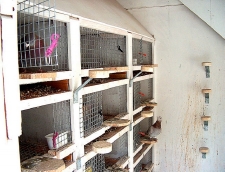
Pigeons will nest just about anywhere, but for rearing young Oriental Frills there are two primary considerations in well-designed nest boxes. First, I prefer nest boxes large enough to provide for double nesting areas. With sufficient size to partition the nest box for two nesting areas, the feeders will stay closer to the youngsters and not neglect their feeding duties whiledriving for the next clutch of eggs. It is essential to partition the nest box so the young cannot disturb the parent on the second nest. Second, space should be provided forfeed and water in the nesting pen. When the youngsters are about three weeks old, they will
learn to eat and drink from watching their parents. When they have been taught to eat and drink in the nest, weaning is much less stressful. Be diligent in providing clean water and feed at each feeding. It is also important to provide good nesting material. I prefer long pine needles and make it available for the birds in the fly pen so they can fill their own nest bowls. This is natural and enjoyable for them, as well as providing good exercise.

SPECIAL CONSIDERATION
The rearing of young Oriental Frills, and other short-beaked varieties, requires some
special consideration. You will learn a lot of techniques, which will aid in raising strong
healthy youngsters. No doubt, you will make mistakes along the way. The successful breeders
are those who learn from their mistakes. I would like to relate some of these techniques that I
have learned from others and my own experiences.
Since we are working with the foster parents (feeders) as well as breeding pairs of Oriental
Frills, timing the egg laying cycle and keeping accurate records is necessary. Be observant of
your birds mating habits. The hens will drop their wings and slightly hump their rump before
they are ready to lay. And the cocks will be driving the hen to the nest following the mating
period. Older hens may sit the nest two or three days before laying to avoid the cock’s
aggression.
Start your stock birds a few days earlier than the feeders. This way, with luck, the Frills
will lay first. Pull the first egg, usually laid around 5pm; replace it with a dummy egg. Then
pull the second egg, laid around 2pm two days later. Of course, if feeders are timed to lay
within a day of the Frills, it is not necessary to pull the Frill’s eggs. Mark the eggs with some
type of code, pair #, date, etc., using a pencil, not a marker pen as it can be lethal.
The eggs that have been pulled and marked can be left on a shelf in the loft in a cool dry place for a few
days, rotate them daily so the sperm doesn’t settle. If they need to be held more than a couple days, or in
hot weather,put them in the refrigerator vegetable drawer. When the feeders have laid their second,
switch them with the Frill eggs. If they were stored in the refrigerator, warm to room temperature before
placing them under the feeders. After the eggs have been incubated about four days, you can candle them to check fertility. If the eggs are not fertile you can use the
feeders for youngsters just past the milk stage or pull their eggs, after 10 days, so they can start the cycle
again. Incubation usually takes nineteen days from the date the first egg is laid. And generally eighteen or
nineteen days after you have started the eggs that were pulled. I have also had eggs hatch that were
incubated a few days abandoned for a day or two and restarted. Although you can pull the eggs from the Frills up to the tenth day, before they start to develop milk, I prefer to let my breeding pairs raise at least one long beaked youngster each clutch, which is their healthy and natural desire. Over pumping eggs from hens
removes calcium from their bones and can be detrimental to their health:healthy hens lay healthy
eggs, producing healthy youngsters.
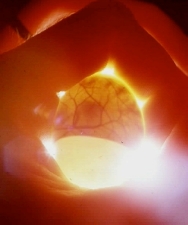
HATCHING TIME
When it’s about time for the eggs to hatch,I like to check them at least the day before their due date. By now you’ll be able to observe that the egg is being piped on the side or you can hold the egg to your ear and hear the baby piping the shell. I check them again the next day, in the afternoon, to make sure the baby has piped all the way around the egg or is out of the shell. I never assist them in this process. If the weather is very dry, however, you can moisten the egg by rubbing a little warm water on the egg with your finger a couple days before it is due to hatch. Dry weather can cause the membrane around the baby to harden when they pip a
hole in the shell, trapping them, so they can’t move inside the shell and pip all the way around, causing death. If it is a healthy embryo the baby will be strong and not have any difficulty getting out of the shell. They have an extra horn on the end of their beak to assist with the piping. If they do have problems, it is pretty certain the baby is weak and did not receive the proper nourishment from the yoke or is sick or genetically weak. These babies will not develop properly, even if assisted and the foster parents will not feed an unhealthy weak hatchling. A good pair of feeders that were timed right with the stock pair’s eggs will start feeding milk soon after the eggs hatch. You can observethem reach underneath and stimulate the babies with their beak
to take food. Photo showing an egg being candled at 4 to 5 days after laying.
ASSISTED FEEDING FOR HATCHLINGS
In the event the newly hatched are not receiving milk right away, which can be a problem
if the timing was off a couple days and the foster parent’s milk was not ready, you can keep
the babies from dehydrating by giving them a little sugar water or a formula such as Enfamil
Lactose-Free, using an eyedropper. Hold them in one hand and offer the food by putting the
eyedropper up to their beak. Let them suck the nourishment from the end of the eyedropper,
don’t force feed them at this early age for fear of suffocating them. Instinctively the baby will
drink just as it would from the parent’s mouth.
By watching your birds close and assisting a little with hand-feeding, if necessary, you’ll
manage to save youngsters that otherwise would be set back in their health and maturity or
even lost.
Avoid disturbing the feeders too much but do keep a close eye on them for any abnormal
signs. If the feeders have strong parental genes they will not leave the nest unattended during
the first ten days after hatching. The young should receive milk for the first seven to eight
days. During this time they will grow rapidly.
NORMAL GROWTH
I prefer raising two youngsters in the nest together; this is normal for pigeons. They stay
warmer and stimulate each other at feeding time. With two in the nest, I have never had a
youngster get straddle legs or rye wings. There are times, of course, when this is not possible;
such as when only one egg hatches or they hatch a day apart, which gives one baby a head
start and the other is unable to compete equally for food. And sometimes one is just more
difficult to feed.
A good pair of feeders should not have any more difficulty feeding two quality Frill
youngsters than they would have feeding only one and you need to constantly strive to
develop quality foster parents. However, occasionally I have had one youngster with a much
wider, blunter beak, which was extremely difficult to feed as it matured. In such a case,
separate the babies or the better beaked youngster will be so much more difficult to feed that
it will get set back. I have gone to the extreme, if another nest isn’t available, sacrificing the
poorer quality baby to avoid loosing the stronger beaked youngster.
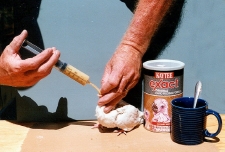
HAND FEEDING AND WEANING THE YOUNG
The pigeon’s normal cycle is to start their next clutch of eggs before the young are old enough to be weaned. This is a critical period for the youngsters, when the cock starts driving the hen. It is a very unusual pair of feeders who don’t neglect their feeding duties and keeping the young covered properly during this
time. Check the youngsters regularly during this period, assisting with some hand feeding if needed. One missed meal will be stressful and detrimental to the youngsters’ health. If the feeders will stay with the young Frills, I prefer leaving them in the nest; assisting only with some hand feeding as needed. However, if
they will not keep the young covered, especially in cold weather, it is best to remove the
young from the nest and care for them in a weaning cage, which should be large enough for
several youngsters and either heated or in a heated room. Provide nest bowls, keeping the nest
litter clean and dry. You can keep youngsters of different ages together, the older ones will help teach the younger ones how to eat and drink. Until the youngsters are at least four weeks old, you will have to hand feed them: up to three weeks of age, they require three feedings a day. After three weeks, you should start cutting back on the force feeding as they begin to eat on their own. They will soon get excited every time they see you and chase after your hands for food. Use this to an advantage and peck with your fingers in the feed and water bowls, like their parent would,to teach them to eat and drink. Be very attentive to young that first
learn to eat on their own as they will gorge themselves with grain and not drink water: you may need to force
their beaks in the water a couple times and remove the feed dish so they don’t over eat.
For hand feeding, I use Kaytee’s Exact original hand feeding formula. It has the vitamins,
minerals and protein young pigeons require. Add water to the powered formula and let sit for
a couple minutes, adding more water as needed. It needs to be thin enough to work smoothly in the syringe. I use a 30cc syringe with a 2-½inch plastic tip. To keep a youngster restrained, I hold its head in my left hand and use my left index finger to hold its mouth open.Holding the syringe in your right hand, carefully insert the plastic tip in its mouth and down the throat. After pumping the formula into its breast,
carefully remove the plastic tip: avoid over filling their crop. With a little practice, you can
get very efficient at hand feeding. When the youngsters are moved to the young bird loft, keep a close watch on them. Make sure they have grit available and are eating and drinking water. If they blink their eyes often,
it is a sign they are dehydrated. You will need to put their head in the water bowl to show
them where it is. Some will drink while you are holding them; others go back to the water
bowl soon after being released.

Young Turbiteens & Turbits eating grain & grit in a weaning pen.
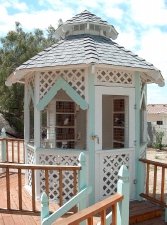
Breeder`s gazebo loft, screened on 5 of 8 sides with wire floor and roof vent for fresh air flow and keeping the loft cool in hotter weather.
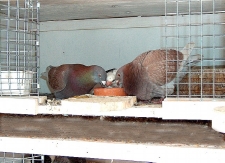
Foster parents teaching a young Turbit to eat grain in the nest box.

The author's hillside "Pachea Trail Lofts" in Hemet, CA. The two gazebo style lofts house the breeders and young birds and larger building has the feed room with mating and weaning pens and foster parents loft on right side with fly-pen.

Foster parents nestbox with space for double nesting, water and feed. With grill floor for easy cleaning.



